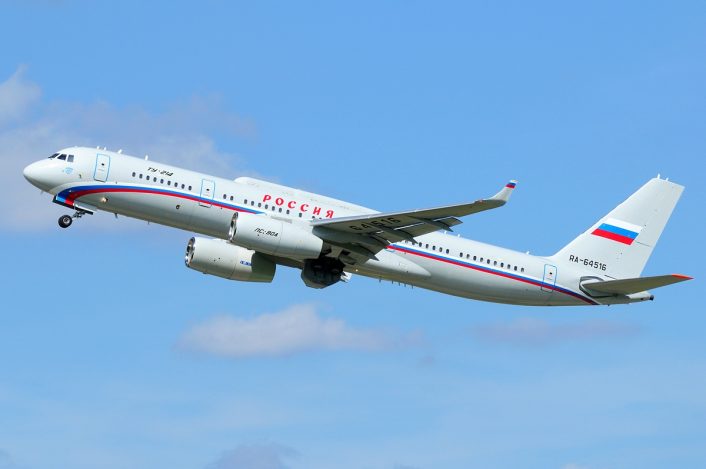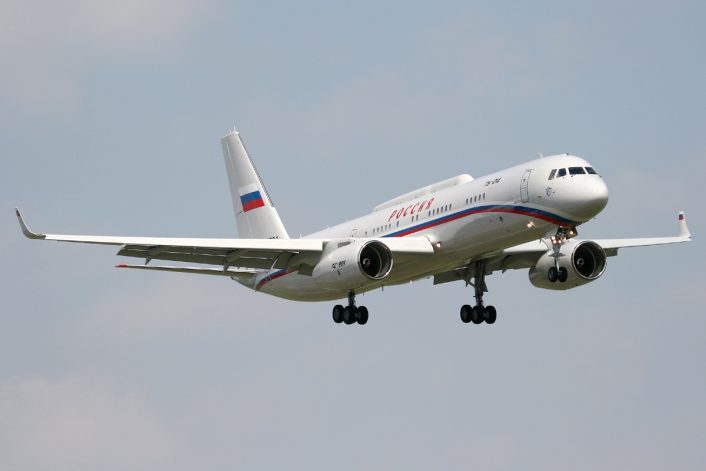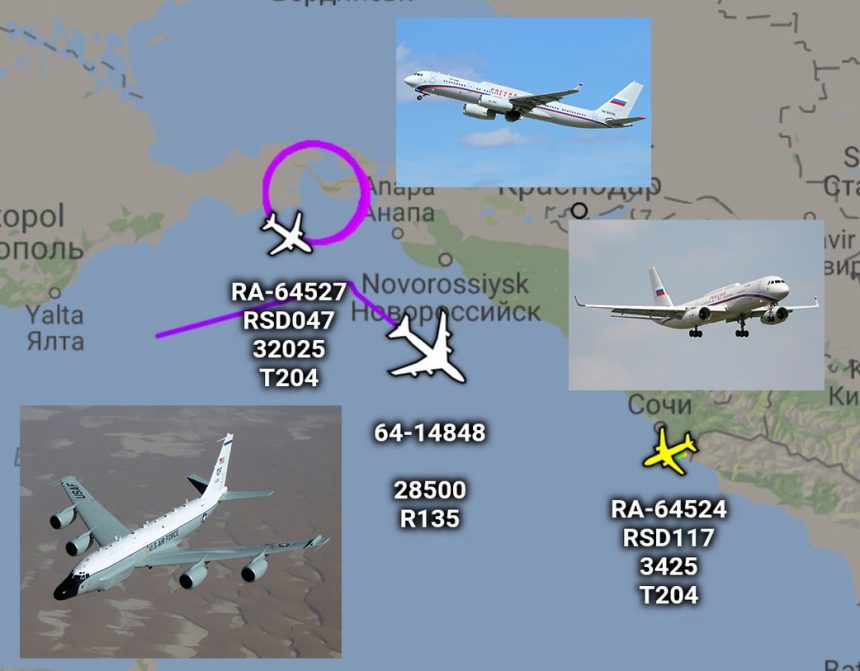Flight tracking websites expose a sort of “close encounter” between a U.S. Air Force RC-135 and some Russian Tu-214 special mission aircraft over the Black Sea.
The Tupolev Tu-214SR is a Special Mission Aircraft of the Russian Air Force. Actually, little details about this special plane are known: the “SR” is belived to be a communication relay aircraft, often accompanying Putin’s presidential aircraft on its travels. In other words, it is the Russian “doomsday” plane, with an airborne command and control role similar to that of the U.S. E-4B.
In spite of its role, as already reported years ago, this aircraft can be tracked online by means of the usual public domain “tools” i.e. flight tracking websites that use the famous ADS-B/Mode-S transponders and, when the aircraft is not broadcasting its GPS coordinates, or via Multilateration (MLAT) a technique that use Time Difference of Arrival (TDOA) to measure the difference in time to receive the signal from four different receivers thus geolocating the target that is not transmitting position data.

Interestingly, a Tu-214SR, registration RA-64527, callsign RSD049, from Sochi International Airport, Russia, has been operating in the Black Sea since Aug. 1. “I first saw it on Aug. 1 at 21:24hrs UK time, same a/c was still on station at the same location on Aug 2, at 07:10hrs (it spent around 11hrs on that location), and it was on station again on Aug. 3”, Twitter user @Andy007_SR_A explained in a message to us.
Rossiya – Special Flight Squadron 🇷🇺
RA-64527 / #RSD049
Tupolev Tu-214 SR
Russian Government airborne comms relay platform. Airborne from Sochi International Airport… #SRAirband @5472_nde pic.twitter.com/RYJt1lDEEI
— SR Airband & Aviation (@Andy007_SR_A) August 1, 2018
What makes the report particularly interesting is the fact that the aircraft did not remain alone during the last mission, when it basically circled over the Kerch peninsula. In fact, on Aug. 3, the Russian “doomsday” plane was somehow “reached” by a U.S. Air Force RC-135V 64-14848 launched from Souda Bay Air Base, Crete, that flew off Crimea then headed towards Novorossiysk.
Now #USAF RC-135 in the area…. #SRAirband @CivMilAir pic.twitter.com/aZewGfpgXb
— SR Airband & Aviation (@Andy007_SR_A) August 3, 2018
The flight path of the Rivet Joint brought the spyplane south of the Tu-214SR’s orbit. Then the RC-135 turned southeast. Interestingly, at this point another Russian special mission aircraft could be tracked online: a Tu-214SUS, registration RA-64524, callsign RSD117. The latter, airborne from Sochi, is believed to be an Airborne Communication Center, “equipped with a communication and special technical means to communicate anywhere in the world en-route and designed to carry the head of state, as well as government delegations.”
RA-64524 / #RSD117
Tu-214 SUS
Another communications platform now airborne from Sochi International Airport
Lots of activity now in the region#SRAirband @5472_nde @CivMilAir @intellipus @IntelCrab @IntelDoge @Surveillance911 @TheAviationist @cencio4 @Buzz6868 @ELINTNews pic.twitter.com/jhjl1GH6AR
— SR Airband & Aviation (@Andy007_SR_A) August 3, 2018
Although the activity of the Tu-214SUS could be completly unrelated to the Tu-214SR (as the operations in the same area for three consecutive days might suggest) it is also possible that the SR was instead supporting the Tu-214SUS, acting as a flying radio relay system between the Presidential/Government plane, ground-based receivers and satellites, as shown in the image below (taken from a ria.ru infographic on the Tu-214SR published by Sputnik news outlet):

After reaching the west of Sochi the RC-135 turned back, following more or less the very same route for its return to Souda Bay. Was it dispatched to the Black Sea to spy on the two Tu-214s ? Most probably yes, even though we can’t be 100 percent sure considered that the Rivet Joint aircraft regularly operate in the area. Still, the fact the U.S. spyplane was there by accident seems to be hard to believe…
Now returning to Sochi International Airport…
64-14848 #USAF RC-135 looks to be leaving the area also… #SRAirband pic.twitter.com/RuLdK0xHWa
— SR Airband & Aviation (@Andy007_SR_A) August 3, 2018
Whatever the reason for the concurrent presence of one American spyplane and two Russian special mission aircraft more or less in the same area of the Black Sea, once again, public domain flight tracking websites provided a privileged look at some sort of “interaction” between an RC-135V, a Tu-214SR and a Tu-214SUS. Something similar to what has happened since the Cold War but can be rarely observed using a web browser from home.










